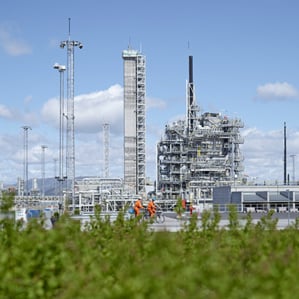The economics of combating climate change may depend on an underfunded technology.
- By Kevin Bullis on April 18, 2014
Why It Matters
The cost of averting the worst of climate change depends heavily on technology investment.

Carbon test: A facility in Norway for testing carbon capture technologies. So far, the technology has not been demonstrated at a large scale at power plants.
When it comes to technology for averting climate change, renewable energy often gets the limelight. But a relatively neglected technology—capturing carbon dioxide from power plants—could have a far bigger impact on the economics of dealing with climate change, according to a U.N. report released earlier this week.
The report is the third in a series of major reports from the Intergovernmental Panel on Climate Change, the first of which came out last fall. This one considers how to limit greenhouse gas emissions to avoid the most serious effects of climate change. The report analyzes the cost of taking steps to stabilize greenhouse gas levels in the atmosphere—switching from coal to solar power, for example, will increase electricity prices and create a drag on the economy. It found that in a best-case scenario, limiting greenhouse gas concentrations to levels low enough to keep global warming to an increase of less than two degrees Celsius would cut global economic consumption by 2.9 to 11.4 percent by 2100. That could amount to between $9 trillion and $80 trillion.
The report found that if solar and wind power fall short of targets, it would increase the cost of limiting global warming, but only by a modest amount—about 6 percent.
But costs could more than double if carbon capture and storage (CCS) technology isn’t deployed. That’s because solar power could be replaced with alternatives such as nuclear power, while CCS is harder to replace. It’s the only technology that can reduce the emissions of existing power plants, some of which will stay in operation for decades. It also might be the best way to limit emissions from some industrial processes, such as making steel.
Most importantly for the economics of averting climate change, CCS could be essential for taking carbon dioxide out of the atmosphere, a strategy the IPCC found might be necessary to limiting warming to two degrees Celsius or less (see “Averting Disastrous Climate Change Could Depend on Unproven Technologies”). A relatively small number of power plants burn biomass, such as wood chips, to generate electricity. These power plants can reduce emissions because the carbon dioxide they emit is offset by the carbon dioxide absorbed by plants as they grow. Adding CCS, and capturing the carbon dioxide from the power plant, results in a net reduction of carbon in the atmosphere.
Some climate and economics models suggest that building a large number of biomass power plants equipped with CCS could lead to a significant reduction in carbon dioxide in the atmosphere, which will be necessary if the world reduces emissions too slowly—something the IPCC report says is likely. Limiting warming to two degrees Celsius will likely require limiting greenhouse gas levels to 450 parts per million, but many models have found that even with ambitious measures to reduce emissions, the world will shoot past that amount by mid-century. To bring levels back down to 450, some carbon dioxide will need to be removed from the atmosphere.
Without the pairing of biomass power plants and CCS, “we find it very difficult to come up with scenarios that pass the laugh test that can limit warming to two degrees Celsius,” says Robert Stavins, director of the Harvard Environmental Economics program. Biomass power plants with CCS aren’t the only way to pull carbon out of the atmosphere. A net increase in forestation would help—but that would buck the trend of deforestation. And experimental technologies that use carbon dioxide-binding materials to capture the gas directly from the air are more expensive than using CCS at biomass power plants, says Howard Herzog, a senior research engineer at the MIT Energy Initiative.
Although CCS is essential to keeping costs down for addressing climate change, the technology isn’t ready yet. CCS hasn’t been demonstrated at a large scale at any kind of power plant, let alone a biomass-fueled one. In fact, in recent years dozens of such projects have been canceled or indefinitely delayed. “Carbon capture and storage at power plants is dying on the vine,” Herzog says.
CCS for all kinds of sources—fossil fuel plants, industrial plants, biomass power plants—would have to increase by about 1,000 times by 2030 and 10,000 times by 2100 in models that limit greenhouse gases to 450 parts per million. Pairing CCS with biomass plants may be particularly challenging, since, according to the IPCC, biomass power plants are difficult to permit and finance. “A lot of publicity was given to the fact that the IPCC says limiting warming is doable,” Stavins says. But the situation “is not as rosy as it’s been characterized,” he says.

Nenhum comentário:
Postar um comentário
Observação: somente um membro deste blog pode postar um comentário.